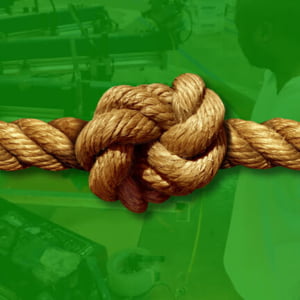Speed.
What is the average production turn-time your shop?
Remember Rocky II, the movie?
Sure, 1979 was a long time ago…but I’ll bet you remember this one. Rocky fights a rematch with Apollo Creed, and has to go through an uncomfortable change to defeat the champ. The trick is simply to become a faster fighter. He starts this training by having to chase and catch a live chicken. Yes, a chicken.
Did you watch it? If not, Netflix and chill my friend.
Of course, Rocky resists the idea of change. At one point the wise-old trainer Mickey gruffly lectures Rocky and says “Chicken chasing is how we used to train in the old days! If you catch this thing, you can catch greased lightning!”
Then, the fun ensues with Rocky, slow and clunky, runs around the alley to grab the quick moving bird. Watch the video clip here.
So how does this relate to your company you may ask?
In the current business climate, you need to be able to catch the chicken. Simply put, does your shop possess greased lightning production turn speed?
Slow = Death
One thing that the online business economy has created is the craving for ever-faster delivery times.
It’s the chicken scrambling around the yard clucking. Bock. Bock. Bock. Bock.
Nobody is patient any more. Including me.
These days customers can go online and in a click or two get the order filled and shipped in a few days. Especially in the decorated apparel industry. Trust me, as special as you think you are…there are tons of shops out there that do it better than you. You need to be able to compete.
If you are still clinging to the seven-to-ten business day model, you may be in for a rude awakening soon.
How are you ever going to knock out the champ?
Ten days? Some shops have it down to a five or seven day turn. Online powerhouse Merch by Amazon is now shipping in two to three days.
Now, that’s chicken-chasing!
Mickey knew that speed would defeat Apollo Creed. Rocky’s superior strength didn’t do it the first time around.
Production turn-time speed is the weapon that you can use to gain more business. Even if you can’t quite handle the less than five business day turns. (Yet)
Improving this area of your shop can have tremendous benefits.
Just like Rocky, you’ll need some help to finally grab that bird. Below are some ideas that will challenge you to think about how you can decrease the gap from order taken to order shipped.
Ready? Let’s go!
Order Entry
It all starts here.
Plenty of speedbumps occur at this phase of the game. Information is missing. Customers are indecisive. Employees have to slog through a confusing system or make mistakes along the way.
Name most any problem that takes your foot off the production gas pedal, and I’ll bet it could be resolved in just how you enter an order.
In your shop, what are the main sticky points that prevent things from happening faster? Have you ever bothered to list them and investigate?
Let’s face it, we are in the custom production order business. Even though the orders are all getting the same type of decoration, they are usually completely different from one another. Even reorders tend to have different quantities and size spreads.
Using the same starting point and order entry methodology gets you to create the answers faster and know what to ask for if something is missing.
Standardize this part of the workflow. Make it easy for your crew downstream to do their jobs.
This means training your front office staff and equipping them with the knowledge base to make good, chicken-chasing fast, decisions. They are your first line of defense for the rest of the shop.
What orders are you taking? When is something due? How does it fit with the rest of the current production schedule? Is that a four color or an eight color job? Can you print a logo on the waist band of some yoga pants? What thread color is a tonal match for Nike Anthracite?
Blah, blah, blah. It’s a never ending stream. But that stream of questions shouldn’t ever be answered by your production teams.
Anything that could hang up production later on must be resolved before the order is entered.
Cramming an incomplete order into the system and hoping it works itself out along the way is a recipe for disaster. Ready, Fire, Aim doesn’t work.
If you want all of the other departments in your shop to work faster, you have to set them up for success by providing them with the answers to the test.
When anyone has to stop and ask “hey what’s this mean?”, it means the order wasn’t entered correctly. Solve it long before they ask. Yes that means you.
Make A Change
Having trouble getting the right information to make the order complete?
Other industries have solved this problem by pushing the challenge back onto the consumer. How many times have you filled out a form online where the fields were mandatory and you couldn’t proceed to the next step until you entered the information?
Why can’t our industry adopt this mindset?
This can be as simple as having an order entry form on your website or a work kiosk in your shop lobby for customers to use. What is it worth to you to have the information in your system without any data entry on your part? How much time and labor savings would that create?
Just set it up that way. It’s your shop. Your rules.
For companies that have customers that use Purchase Orders, you could incentivize them by offering a faster turn time, free screens or even a monetary incentive to use your system. What you want is the information getting into your production funnel faster with more accuracy.
Think beyond the empty order form box. What do you need to get the order information complete? Are you asking the right questions?
Inventory
Another crucial cog in the chicken-chasing machine is how you are handling inventory.
For many shops, they are geographically blessed with being a one day ground ship from major apparel distributors. Order Monday. Shirts delivered Tuesday. Simple.
That essentially solves most inventory-based production time challenges. Unless of course, they are out of stock on an item or size and it has to ship from across the country. Then, that can throw everything off.
Some shops aren’t so fortunate. They may be two days or more from these distribution centers or in a more remote area.
Solving that challenge usually means stocking an assortment of brands, colors and sizes. Like restaurants with house wines, shops have go-to stock shirts they have on hand.
The most popular t-shirt colors will always be White, Black, Sport Gray, and the local team colors. Currently the trend is pushing popular style colors into heathered varieties.
Getting all of these choices into one area of the shop could be a footprint challenge. Not to mention the hassle of actually taking care of the inventory. Figure it out if this can make your shop faster.
For a better customer service experience, do your research and know how long it takes to get the inventory in for the best selling and popular brands, styles and colors that you are going to offer. Make this information available. Your goal is to compress the shirt delivery time for orders as much as you can for a lion’s share of your work.
It doesn’t have to be a crazy assortment either. What if you just stocked white or black in one brand? Do some data mining in your system and determine if that makes sense just from the color standpoint alone.
“Sure Mr. Customer we can order these black t-shirts, but if you go with our stock Gildan (or insert your shirt of choice), we can produce that order a few days earlier.”
Would that make a difference?
Plenty of customer driven production programs are built by ordering in a larger stock of items and then pulling from that for daily or weekly orders. Shirts in the building means immediate production capabilities.
Press two, no waiting…
Manage the Inventory
One of the biggest hangups with keeping a production schedule tight lies with how the inventory is being managed. You can’t decorate shirts unless they are counted, received and staged. How good is your crew in this area? Clean, organized and efficient? Good at math? The good at math part is essential by the way.
A good rule of thumb to follow, is that the inventory has to be checked in the day it arrives. All shirts are counted and inspected against the vendor’s packing list. The packing list is then reviewed against the system order information. If everything is complete, the job is marked as such and then staged for production. Challenges with counts, color, styles or damages have to be reported immediately and acted upon.
Want faster shop speed? Get your inventory under better control. Don’t leave it to chance.
Art
As you know in the decorated apparel industry we don’t ship many blank shirts. There has to be some sort of image applied to the garment.
That something comes from the talent and skill of your art team. While some artists can work faster, the friction point for turn-time speed doesn’t usually rest with these folks.
The problem for getting art approved almost always is with the customer. In your shop is it any different?
Some shops are using a new app called Instaply to get these approvals opened and approved immediately. I wrote about this in my Shop Tech Solutions article a few weeks ago.
How are you managing this process? The faster you can get from order entry to art approval, allows you more time for the production crew to work their magic.
Some more points to consider:
First, if you are constantly having to make multiple changes to designs before they can get approved, something isn’t quite right with your process.
- Sales people are notorious for the “Do something cool” set of instructions. Or, my other non-favorite, “just do two or three designs and they’ll pick the one they like the best.” Can you say lazy? You are better than this. Why do two or three times the work for one order? Dumb.
- The second is just a picky client. There are people out there that always have to make a change as that denotes “control”. Nothing much you can do about that, except try to reign in these folks by getting hyper detailed instructions from the onset. Shoot them layout thumbnails that you’ve scribbled together early. Bring them along in the process so that control urge is sated, and the final art approval comes faster as they have already made their changes known. They just want to taste the soup and say add more salt.
Production
To increase production turn-time speed you need to look at a few areas.
First, where are the bottlenecks?
Maybe you have room on your machines, but you are waiting on the files to be digitized or screens to be burned. Maybe you have the job set up, but your crews are waiting for someone to get that PMS 3005 blue mixed. Maybe you’ve produced a sample, but need the client to approve it before running the order.
I’m sure you can not only relate, but can name your top issues as fast as you can name your children. The point is that you need to resolve those challenges to increase your speed. Are you doing anything about them really? Most shops know they have problems, but lack the willpower or knowledge base to squash them.
Get more people trained to digitize embroidery files. Buy an LED CTS screen system. Have inks mixed the day before the job is to run. Have sample orders created as their own jobs separate from the production order. When the sample is approved the clock starts on the real one.
Next, look at your equipment and staff. Do you have enough of both? Are they the right kind?
Typically, newer equipment and seasoned staff members work better and faster. Is that what you have in the shop now? Or, are you making do with used fifteen year old machines and a bunch of temporary workers that don’t know anything?
Want greasy chicken-catching speed? Maybe it’s time to rethink your production equipment and staffing strategy!
Make It Easy
Catching a scared chicken can get easier if you corner it. Then, it doesn’t have anywhere to go and you can reach down and just grab it.
Increasing speed in your shop is the same way. Just make it easier for people to do the right thing.
How many more turns a day in your embroidery department do you think you get if you brought pre-hooped shirts to the machine and just lined them up? Can’t afford a gazillon hoops? How about just adding one more person to the production table to hoop? Especially on low stitch count jobs. Those always go quick.
You can even think about how you stage things. Line up everything needed by each of the production workstations, in the order that they need to be produced. Take the “what are we doing next” question off of everyone’s lips.
This means that you need to be proactively looking ahead. Imagine the joy and delight your production crews will have when everything they need is two feet away. Someone stages the shirts, ink, thread, samples, work order documents, approvals and anything else needed to run the job.
It’s just magically there ready to go.
Repeat After Me:
Today’s production is set up yesterday. Tomorrow’s production is set up today. That’s your new mantra.
The push is to constantly get things out early. The earlier the better. Jobs that have to ship today should be produced yesterday. Two days ago or more is even better. Go! Go! Go!
What do you have to do in your shop to get to that level? Is this something you are even discussing? Or are you the shop that had the job that was supposed to ship Thursday, but it didn’t go out until the following Tuesday? In fact, the client had to call and ask when it didn’t show up on Monday.
That’s not doing you any favors.
What are you willing to do to build speed? Are you happy with just watching the chicken run around? Bock. Bock. Bock. Bock.
Other shops are training in the alley to grab the chicken. Here’s what they are doing:
- Investing in production technology.
- Digital printing on garments means zero screens.
- If you use screens, Computer to Screen technology means screens ready to wash out incredibly quickly. M&R’s STE handles it in under a minute per screen.
- Automated coaters means perfect emulsion on screens. For better flow, buy the one that coats two screens at a time.
- Instead of one overbooked single head embroidery machine, what about several lines of eight or twelve head machines?
- Paperless production. How much time would you save if you never printed another piece of paper again? Think about the effort you spend right now walking paper around your shop. What if that went away?
- Touch screen monitors on the floor.
- Managers with tablets.
- Barcodes on boxes.
- Everything in the cloud.
- Shop operating software. This stuff has been out there for a long time. Are you still using whiteboards and spreadsheets? Do you use an abacus instead of a calculator? Did you remember to tie up your horse when you rode into work today? Seriously, time to modernize don’t you think?
- Limiting choices. Build your business plan and focus on developing things so they make sense. Why worry about struggling with printing that yoga pants waistband order when your main customer is servicing rock band tour merchandise? Let some other shop have that job and keep your schedule uncluttered. Or just outsource it and still make the money. Use your noggin’.
- Eliminate clutter. A clean shop is a faster shop. Being a slob slows you down.
- Quality is job one. Doing it right the first time is always faster than a million miles an hour and wrong. Redoing anything is a waste of time. Measure twice, cut once.
- Focus on technique. In our industry, it’s the science behind the craft that drives the results.
- There are 24 hours in a day. How much of that time are you producing? Want to drop your published turn times by several days? What about more shifts? What would you need to build that?
- Look at your downtime too. During each shift, how much of that is actually decorating a shirt? Are you measuring? What’s your up-time percentage? If you don’t know, why not?
- Hiring better staff. You get what you pay for. When you only hire minimum wage folks, you get minimum wage thinking. Don’t think you are saving any money by being cheap. Maybe that’s what is holding you back.
- Setting standards and building staff training programs. Decide how you want your business to work and train on it. When everyone is on the same page you move faster.
Getting faster in anything is a culmination of a lot of work. Trying and tweaking many things is going to produce the results you want. Eliminate the wasted steps. Ask why a lot. It’s going to be a team effort. It can’t be just the owner or a manager barking orders.
Teamwork will drive your success.
Then the victory phrase is “Winner, winner…chicken dinner.”
.
“Life is like a ten speed bicycle. Most of us have gears we never use.” – Charles M. Schultz
“The speed of the leader is the speed of the gang.” – Mary Kay Ash
“When you call upon a thoroughbred he gives you all the speed, strength of heart and sinew in him. When you call upon a jackass, he kicks.” – Patricia Neal




4 comments
Kesa
This could not have been more timely. Thank you! Now I’ll spend the day at my sons’ basketball games planning a strategy to catch the chicken.
atkinsontshirt
Kesa – live chickens and basketball – now that is something I’d like to see.